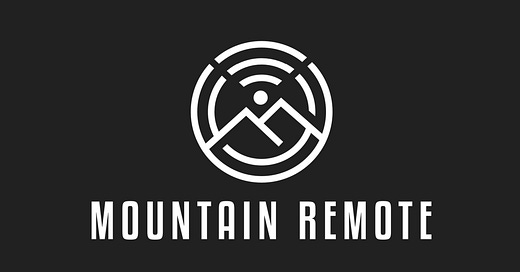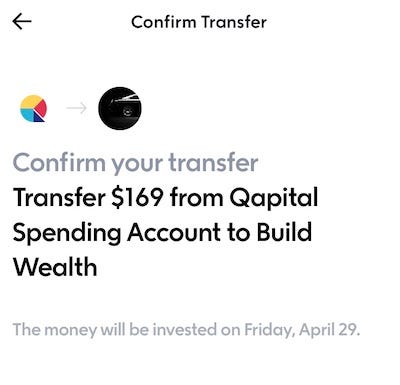Financial freedom happens $169 at a time
Hey reader,
It wouldn’t be out of line to say that fintech apps have revolutionized my financial situation. Over the past five years, I’ve saved and invested more than $80,000 through two apps on my phone.
That’s not a life-changing figure, at least not yet (come on, compound interest), but what sticks out to me the most about the progress is how easy it is, provided I maintain steady earned income. And, how good it feels to be proactively taking steps towards financial freedom.
Today’s essay is a new topic for Mountain Remote, and a topic I hope to revisit frequently going forward — how to actually pay for the lifestyle design that a mountain-based, remote work lifestyle demands.
After all, you’ve gotta do the dirty work if you want the perks. In addition to basic frugality (my wife and I were a one-car household for years, up until the arrival of our baby girl), automated savings and investments add up a lot faster than you might think, at least in part because you’re not actually doing anything.
Community Shoutouts
Six new subscribers since the last dispatch — welcome! Coming in hot on finance week. Mountain Remote is a community of people who value two things: lifestyle design and outdoor adventure. You’ll fit in just fine.
Thanks to everyone who wrote, texted, or told me their thoughts on the last essay (here it is if you missed it). It turns out that the similarities between Hemingway’s Paris and the digital nomad movement resonated with a lot of people — I received more comments on this essay than any other, so far.
On that note, I’d love to hear what you think about Mountain Remote. Hit “reply” to this email and let me know (or if you’re reading on the web, here’s a direct link to email me).
Lastly, I want to shoutout a Substack I’ve recently started following and have greatly enjoyed — one that is quite related to what I talk about frequently here on Mountain Remote. Counterflows, by Lauren Razavi, offers excellent insight on living a borderless life. As the Director of Special Projects at SafetyWings (nomad health insurance), Lauren is in charge of the monumental task of literally building a country on the internet. I, for one, can’t wait to read her new book, Global Natives. Check out Counterflows for some good reads.
Now, let’s break some budgets.
Financial freedom happens $169 at a time
I am not an expert investor or a financial advisor in any sense. The strategies I explain here are exactly that — strategies that I myself have developed and honed over the past decade, and really focused on over the past five years or so. These are not perfect, and there are probably mathematically better ways to get returns than what I’m doing.
That said, these strategies, while they require discipline, take very little actual effort. Which makes them ideal lifestyle design strategies for busy people.
Of course, the prerequisite to all of this is that you make more than you spend, and otherwise have your ducks in a row. I highly recommend reading through Mr. Money Mustache for a degree’s worth of knowledge — conveniently laid out for 101-level apprehension — for advice on how to trim the fat from both your expenses and waistline, at the same time.
With that, here’s how fintech gave me the ultimate financial paradigm shift.
$169 turns into $30,000
In the fall of 2018, my relationship with my finances took a major step forward. You could say we, or at least I, finally got serious.
I began putting $169 per week from my checking account into a Qapital Invest account (more about Qapital below) in November of that year. I made the decision to do so while eating a sandwich at The Standing Room in Hermosa Beach, California, on an otherwise routine Friday afternoon (I chose this restaurant while in town for the weekend because it is owned in part by Fletcher Dragge from Pennywise).
Prior to that point, I had an IRA and a savings account, and due to the lack of enthusiasm I felt for both, I put a minimum amount of effort into either. A good year would see me deposit $2,000 into the IRA.
I’d had a Qapital goal savings account since early 2017. But the company’s new investment tool intrigued me due to its simplicity. The difference between the investment account and savings account is that this money goes into a managed investment portfolio that acts somewhat like an index fund, in that it puts your money into a conglomerated portfolio of investments including equity, ETFs (actual index funds), bonds, and REITs (real estate investment trusts).
Once you sign up, there’s no effort required on your part outside of making deposits. Also like an index fund, Qapital charges a very small management fee.
This hadn’t been the plan. I didn’t even know that such an investment option existed.
Already a user of the Qapital app for a savings account, I had received a marketing email from them earlier that week announcing the launch of Qapital Invest. Hands-off passive investing, it promised. I’d debated signing up since, and greased by a couple of cold beers at the restaurant on that sunny Friday, I took the plunge.
Why $169?
After signing up for an investment account, the app asked me how much money I wanted to have invested there in five years.
I wanted to have $169.
For real though, I had no idea how much money I desired to have sitting in this portfolio in five years. One million? Sounds great, but likely not feasible unless this low-risk portfolio finds itself the next Apple right before it launches the next Macintosh.
$50,000 sounded doable to me. So I entered that number.
The app informed me that in order to reach that goal, I would need to contribute $169 per week, every week, for the next five years. Combined with the portfolio’s expected return, my $43,940 total contribution would net me $50,000.
Ok. That’s a massive commitment — at that point, I hadn’t even been with my wife for five years. I’d never held a job for five years.
But I signed up anyway, and whether or not it was the beer talking, I convinced myself that I would do it. I set up the automatic deposits, put in my first $169, and finished my sandwich.
As of the end of April, 2022, the account balance is just north of $33,000. To my own surprise, I’ve stuck to the weekly deposit schedule. After a few months of becoming accustomed to the hit to my bank account each Tuesday, I began budgeting it into my monthly bills so as not to have to think of it as an added expense.
It’s actually proved so simple that when the five-year commitment reaches maturity next year, I plan to double down and go for another five years. Because $150,000 sounds a lot better than $50,000.

Doing what is manageable for you
I don’t have one million dollars, and therefore am not a certified investor. I also don’t have some genius financial plan that has been passed down through my family lineage.
But what I do have, hopefully, is two things: time, and the willingness to work really hard. What’s great about modern technology as it pertains to personal finance is that it allows you to do what you can, when you can, and turn that into long-term results.
I’m no genius but it appears to me that the best way to invest is to invest in tomorrow, not today. Sure, I could use that $169 each week to buy a bigger house in a hipper city than where I live, with a more expensive mortgage payment. Or buy a shiny new car instead of my aging pickup. Then I could use further installments of $169 to buy more stuff to fill up my bigger house. And to keep my new car clean.
Or, I can put that $169 away every Tuesday, and use it later — when I need it — to spend more time with my daughter, ride more powder days, and travel more often. That could be in five years, 10 years, 20 years.
I don’t know exactly what I’ll want then, but I know what I won’t want — excessive stuff, excessive bills, and stress about money. Each $169 investment reduces the chances of each of those things.
In my case, financial freedom happens $169 at a time. And that’s just fine.
There’s an app for that
Now, for the backstory.
Financial technology, often shortened to FinTech, has made saving money easier than ever. Back in 2017, a friend told me about an app called Qapital. By using the app, she had saved enough money in one year to travel to Peru and trek the Inca Trail.
Intrigued, I downloaded Qapital for myself. I found it incredibly easy to use. I created an account, and then the app prompted me to create a savings goal. I wanted to pay off my truck, on which I owed about $15,000, so I set up a goal to save up enough to pay the truck off in two years.
Qapital figured out how much I needed to deposit each week in order to do so (about $145), and prompted me to set up a recurring deposit from my checking account into the new savings account set up through the app.
I have to admit, I didn’t stick to that goal. At least not at first. A couple of weeks into taking that financial hit, I turned off the automatic deposit. It took a good three months before I put it back on.
I stuck to it, more or less, for long enough that I was able to pay off my truck (with financial input the sale of my condo in the Denver suburbs) a couple of years early, though not as quickly as I’d hoped.
Clearly, this first experience didn’t go nearly as well as the second.
In 2019, inspired by the progressively rising amount in my Qapital account and increasingly confident in my ability to save, I took another fintech dive on app called Fundrise.
As far as user experience on the investing side, Fundrise works exactly like Qapital invest — except you’re investing only in REITs. So, effectively, you own very small slices of large-scale real estate projects like apartment complexes and industrial warehouses.
To test the product, I started with a $1,000 investment, and set up a recurring $125 monthly deposit. The returns here have been even better than I expected — I made another small-ish, but large for me, lump-sum deposit in 2021 and have seen returns topping 20% over the three years since I signed up. The app takes a 1% service fee on profit.
Here’s to future powder days
This is a newsletter about lifestyle design powered by remote work and a love for outdoor adventure in the mountains. What most excites me about streamlined investment portfolios like the two mentioned above is that they give you the power to see consistent, if modest, returns on your money without interfering with your lifestyle, or having to pay for a financial advisor.
While the investments themselves are rather boring, and certainly not “impact investing,” I hold out hope that because these are forward-thinking companies, they will be quick to adapt to changing market conditions and in the case of Qapital, quick to support large companies working to offset their environmental impact.
If you’d like to try one (or both), you can grab a small boost in your initial deposit right away from either, by signing up through the links below.
As a bonus, you can get some free money ($25, to be exact) by signing for Qapital right now. I’ll get a kickback too, making this a great way to support Mountain Remote.
And, if you’d like to try Fundrise, here is the link to sign up and earn $50 in bonus shares after you make your first deposit, and I’ll get the same.
Mountain Remote news and further reading
My wife, Alisha, and I are heading to Mexico in a few weeks with our 7-month-old daughter. It’s to be her first time abroad, and we have a lot to learn. So I interviewed Monet Hambrick, founder of The Traveling Child, on my podcast, No Blackout Dates, to get some tips.
A formal un-settlement of remote workers on Madeira have come together under the umbrella of Digital Nomads Madeira. This excellent report in GQ chronicles how an unlikely island off the west coast of Africa became a remote work hub.
Thanks for reading, see you next week! If you dug this essay, please forward it to one person who would also enjoy it.





